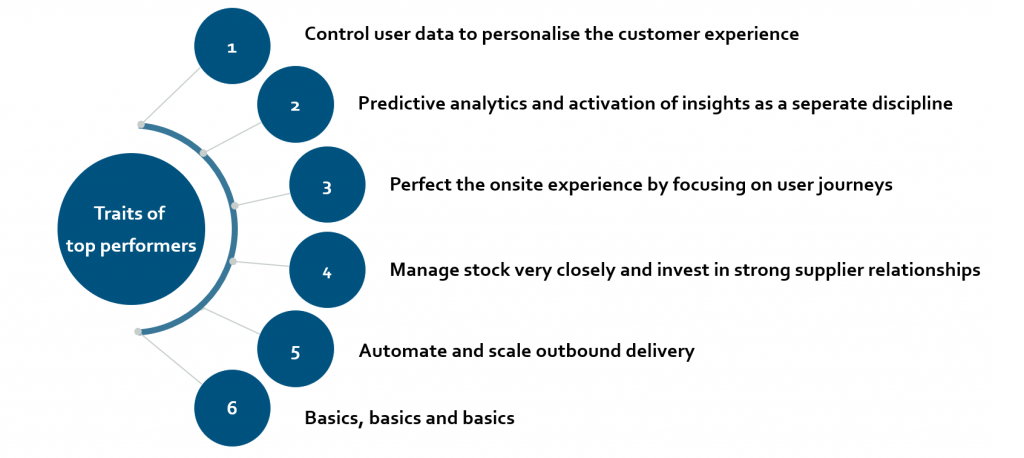February 18, 2021
A lot of the discussions and media hype about ecommerce has been centered around the extraordinary growth within ecommerce. We have all seen ecommerce demand accelerate at a pace that has brought us 2-3 years ahead of the projected growth curve in a matter of a few months.
However there are not as many articles published into how this has affected companies operating in the ecommerce space and the decisions at management level. How has this changed or affected management prioritisations? What are the most important areas to address in your business? Where have other companies executed most successfully under these changed marked conditions?
Working closely with and talking to many of the largest ecommerce companies and brands in the world, we are close to the strategic decisions taken by CDO/CMOs within ecommerce and therefore where they have executed in their businesses with most impact. We would like to share the observations we have made.
We have gathered this in 6 prominent traits that have led to extraordinary successful performance through COVID-19.

1) Control User Data to Personalize the Customer Experience.
Having a well-structured CDP (Customer Data Platform) in place is more important than ever. Most companies have a CRM and a lot have talked about DMP’s. But having a CDP is more crucial than ever. This is the only platform that can enable identity resolution and manage personalization. This links very closely to the current COVID-situation. Your CDP capabilities define how efficiently you personalize each touch point with the customer, and thereby improve how you attract and convert new customers. The CDP is a cornerstone in creating long term loyalty and a personalized experience – factors that have shown increasingly important and will continue so into a more normalised marked. On top of this we have also seen CDP’s bringing top performers a number of other advantages (automation of marketing processes, the ability to break down data silos, better segmentation of marketing campaigns etc.)
2) Predictive Analytics and Activation of Insights as a Separate Discipline.
Analytics and insights are moving to the center of successful ecommerce operations. There are clear signs of this discipline arising as a foundation and enabler for a significant improvement of the customer experience. Predictive analytics is moving into the space of activation of data, and models are used in real time to create a relevant and personalized experiences for each single user. Building predictive models based on machine learning is becoming a discipline that is needed in digital marketing and ecommerce organizations.
3) Perfect the On Site Experience by Focusing on User Journeys
Not a time to panic. Your existing tactics are not fundamentally challenged if you feel in control of your online channels, of your segmentation and customer lifetime value. There have been 3 most common observations for most. Firstly new custumer groups are increasing in volume – particularly the older generations but also younger audiences that are gnerally digitally native but equally attracted to the physical shopping experience. Secondly some channels are suddenly increasing in relative importance – particularly direct traffic, SEO and to some extent social traffic which has been increasing more than average. Thirdly particular categories or specific new products have suddenly been selling more than normal. The key to addressing each of these 3 developments is to focus your organisation on customer journeys and optimisation of online touch points through rigorous A/B testing. This is nothing new – but typically it has not been perfected in many organisations– and if you really want to differentiate this has been the time to address it and drive impact due to the massive amount of customers visiting your site.
4) Manage Stock Very Closely and Invest in Strong Supplier Relationships.
Always having products in stock has always been a key differentiator in ecommerce and defining ecommerce companies with growth rates ahead of everyone else. In this area the COVID-situation also put purchase departments in a new situation. Getting hold of products from suppliers, getting enough of them and pricing products in situations where only some companies were in stock. Across different ecommerce sectors we have seen the companies with the best cockpit overviews of their SKU depth and volume (either through dashboards, PowerBI etc.) emerge more successfully. And we have seen ecommerce companies that have invested in close relationships with their suppliers capitalise on this by getting preferred access to products in categories with scarcity.
5) Automate and Scale Out-Bound Delivery.
The sudden explosion in demand has challenged ecommerce operations, making it harder to deliver packages fast enough. Those that have come out successfully have either managed one or two of the following aspects. They have been able to scale-up recruitment of staff and / or they have invested in automation – obviously with the most automated warehouses having a real differentiation with the ability to work 24/7 without breakdowns and lower risks of COVID spreading amongst colleagues.
6) Basics, Basics, Basics.
We can’t stress it enough, it's so important that you control your basic ecommerce operations. This also holds true in these disruptive times. It comes as no surprise that those operating marginally better than competition on 1. selection, 2. pricing and 3. delivery, harvest growth and profitability that is on another level. Someone might wonder where marketing is in all this. Obviously this is very important – however we do not see this discipline in a narrow sense being as important as the 6 traits that we have been focusing on in this article.
Get Ahead of the Curve to Differentiate.
The pandemic did not make ecommerce a new kind of business, it just accelerated the progress that was already going on – ecommerce businesses are just “growing up” faster than expected. And this is truly good news as it means that most companies can reach scale and profitability-levels not seen before.
Looking at the 6 traits of successful performance addressed in this article they are obviously not an exhaustive list of what to address in your ecommerce business – and it is impossible to shine on all of them. But what we know is that if you put an extraordinary emphasis in one or more of these areas you can significantly affect the main KPI’s of your ecommerce business. Typically the top performers that have done this have not just harvested more growth in revenue than competition. They have also seen their ability to execute on these select areas kick in on the bottom line and they have managed to establish lucrative long lasting relationships to attractive new customers.











